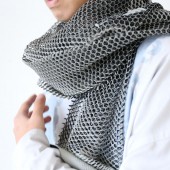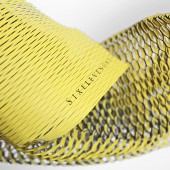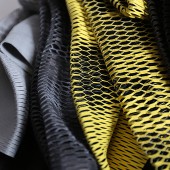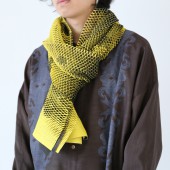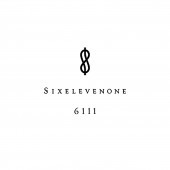Deer Mesh Stole by Kohei Nishino |
Home > Winners > #126757 |
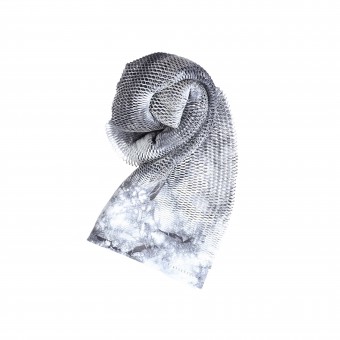 |
|
||||
| DESIGN DETAILS | |||||
| DESIGN NAME: Deer Mesh PRIMARY FUNCTION: Stole INSPIRATION: A new challenge leather stole lay behind the designer's inspiration for this piece. Central to this design was the designer's wish to produce fashion apparel made of sustainable material, with a stole being his first design. The stole is made from sustainable deer leather, sourced from venison producers in New Zealand. A further deciding inspirational component was a desire to use a fundamentally Japanese traditional craft, that of applying gold leaf to the stole. The designer sees gold leaf as a symbol of Japanese tradition and luxury. UNIQUE PROPERTIES / PROJECT DESCRIPTION: Bringing together time-honoured Japanese craftsmanship and modern uniqueness, this double-face mesh design leather stole, made of two layers of extremely thin deerskin to which traditional Japanese gold leaf has been applied, is a first. The mesh design is the main contributor in making the stole light, supple and comfortable to wear. A traditional leather stole may give the impression of being hot, heavy and unwieldy, however, the extremely fine leather and mesh design are proof to the contrary. The stole is available in a variety of solid colours as well as the traditional Kyoto tie-dye. In addition to these designs, a particularly luxurious piece was designed. A stole to which gold leaf has been applied using the traditional Kanazawa method. It is the same process that was used to gild the Kinkaku-ji temple (Golden Pavilion) in Kyoto, which was awarded the status of Intangible Cultural Property. Also, the leather used is sustainable material, which is from venison producers in New Zealand. In addition, deer leather is also excellent in water immersion, making it less stuffy than other leather. The leather becomes soft and supple with time and use. The more you use this stole, the better it drapes, becoming even more wearable and beautiful over time. For this reason, the designer refers to this item as an evolving stole. The stole is available in a variety of solid colours and the traditional Kyoto tie-dye. In addition to these, a particularly luxurious design was created. A stole to which gold leaf is applied using the traditional Kanazawa method. It is the same process that was used to gild Kinkakuji temple (Golden Pavilion) in Kyoto, which was awarded the status of Intangible Cultural Property. The designer regards gold leaf as one of the symbols of Japanese luxury and that of Kanazawa. A unique and valuable item of clothing was created by applying Kanazawa gold leaf to a deer leather stole. It is the hope of 6111 that consumers will enjoy this unique stole which will develop and improve with use and time. OPERATION / FLOW / INTERACTION: A stole is usually a consumable item, but since this stole is made of leather, it will adapt itself to the skin of the wearer the longer it is worn. The company calls it a growing stole because it becomes soft and expandable as it is used, changing the concept of consumable stoles. In addition, this stall is meshed so it will not wrinkle easily even if badly stored. It can be worn by both men and women. PROJECT DURATION AND LOCATION: The project started in 2015 in Japan and finished in 2020. FITS BEST INTO CATEGORY: Fashion, Apparel and Garment Design |
PRODUCTION / REALIZATION TECHNOLOGY: The leather is produced as a byproduct of deer raised for meat in New Zealand. The leather is of consistent quality with few blemishes. The leather is made from a single piece of leather with no seams on either side, maximising the amount of leather that can be used per animal to avoid waste. The leather is dyed without any surface treatment to preserve its softness, smoothness, breathability and retain its natural texture. The surface finish does not deteriorate over time, and the leather becomes more comfortable as it is used. The leather is thinly made to 0.3 mm and then 2 pieces are laminated to each other to reduce fluff and ensure strength. The material used for lamination does not affect the softness and breathability of the leather. Kyoto tie-dyeing is a traditional craft in Kyoto. The traditional technique used for washi paper and kimonos is applied to deerskin. The delicacy of tie-dyeing is expressed by applying it to 0.3 mm thick leather. Honeycomb is cut to secure length, give moderate volume and make the stole light weight. In addition, the mesh design finish provides breathability. The gold leaf used is 1/10,000th of a millimetre, an intangible cultural asset, and is made much thinner than normal foil using a technique handed down from ancient times. The foil is characterised by a beautiful whitish gold colour with very little yellowing. Kanazawa is particularly famous for its gold leaf and presently, Kanazawa is the largest producer of gold leaf in all of Japan. Throughout history gold leaf has been used to decorate temples, shrines, palaces, Buddhist statues and altars, as well as paintings and works of craft. Even today, gold leaf is applied to accessories, as can be seen in this deer stole, food and cosmetics. Gold leaf workshops began in Kanazawa at the end of the Edo period (1603 – 1868) and today artisans maintain the tradition. SPECIFICATIONS / TECHNICAL PROPERTIES: A short stole of about 70 cm in its unstretched state. Feature film is about 80 cm. When stretched, it grows from about 160 cm to about 240 cm. Since it is leather, the longer it is used, the longer it will grow, therefore the exact length cannot be stipulated. TAGS: stole, leather, Gold leaf, Sustainable, Deer leather, fashion, gold, accessory, fashion item RESEARCH ABSTRACT: Based on the designer's reflection of wanting to produce a variety of clothes made of sustainable materials, he reached the conclusion that he wanted to use quality leather of animals which are already consumed for their meat. He subsequently started thinking about what kind of item to produce and decided on designing a comfortable stole made of leather. Obstacles to overcome were to find a leather which was very light and not stuffy, while at the same time being durable and thin. These various quests were answered in collaboration with a team of experts who were involved in the product development of the leather. The designer arrived at deer leather as a leather that is durable even when it is thinned down, remains soft to the touch and does not get stuffy. Deer leather is durable even when thinned, so the designer developed a technique to reduce its thickness down to 0.3 mm and therefore achieving a lighter material. Furthermore, the designer succeeded in developing a stole that is more comfortable to wear by pasting together two thin deer leather pieces and applying mesh processing. As this stole is worn, the texture transforms from when it was initially acquired. A leather stole that can be used indefinitely was thus created. CHALLENGE: In pursuit of lightness and excellent wearability, the designer worked deer leather to less than 0.3mm thick, and used two pieces for the double-faced finish. ADDED DATE: 2021-06-14 10:03:49 TEAM MEMBERS (2) : KOHEI NISHINO and MANABU SHIRAYAMA IMAGE CREDITS: Kohei Nishino, 2021. PATENTS/COPYRIGHTS: In2011 SAKURA GROUP CO.Ltd. |
||||
| Visit the following page to learn more: https://koheinishino.jp/ | |||||
| AWARD DETAILS | |
 |
Deer Mesh Stole by Kohei Nishino is Winner in Fashion and Travel Accessories Design Category, 2021 - 2022.· Read the interview with designer Kohei Nishino for design Deer Mesh here.· Press Members: Login or Register to request an exclusive interview with Kohei Nishino. · Click here to register inorder to view the profile and other works by Kohei Nishino. |
| SOCIAL |
| + Add to Likes / Favorites | Send to My Email | Comment | Testimonials | View Press-Release | Press Kit | Translations |
Did you like Kohei Nishino's Accessory Design?
You will most likely enjoy other award winning accessory design as well.
Click here to view more Award Winning Accessory Design.


